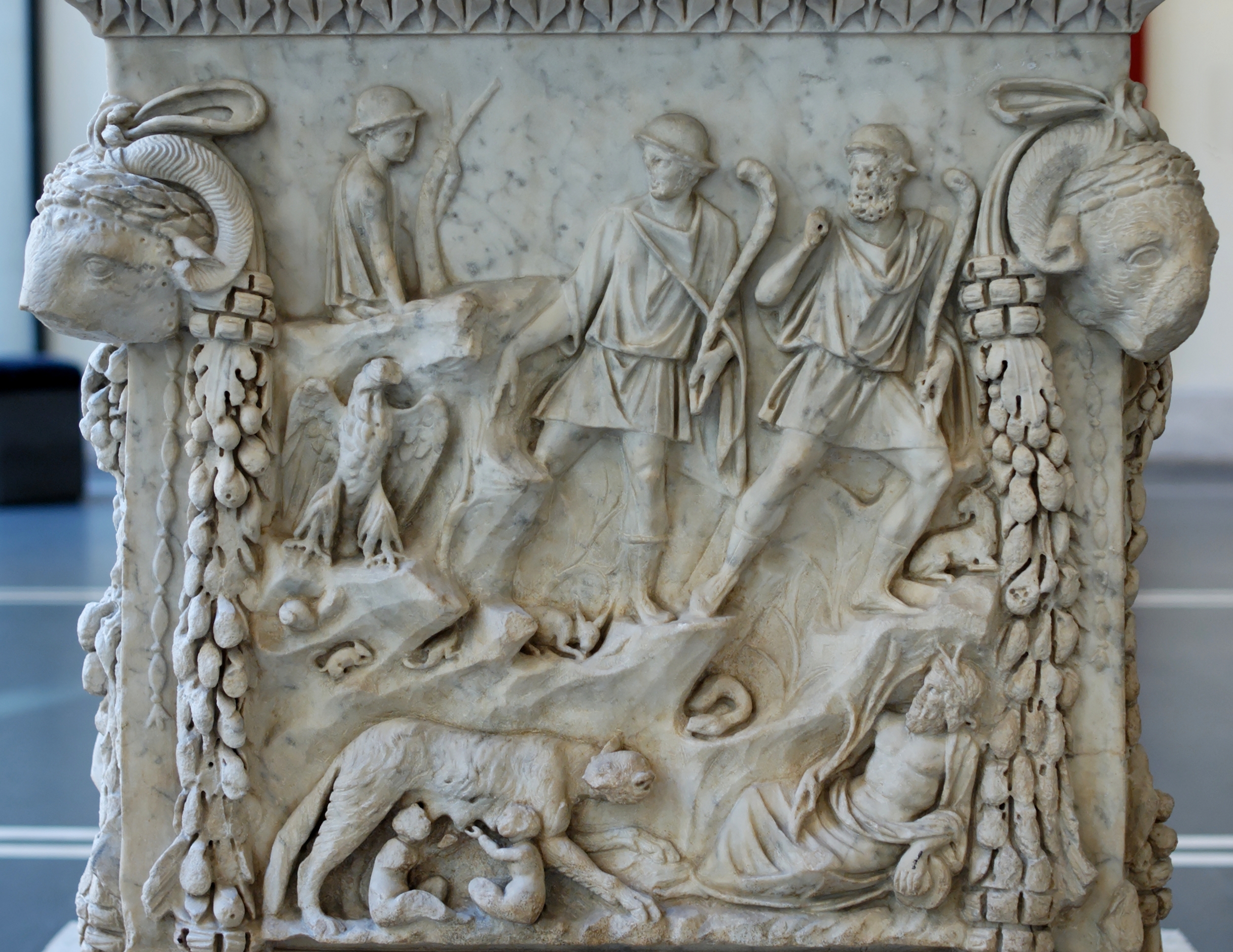|
Verminus
In Roman mythology Roman mythology is the body of myths of ancient Rome as represented in the literature and visual arts of the Romans, and is a form of Roman folklore. "Roman mythology" may also refer to the modern study of these representations, and to th ..., Verminus was the Roman god who protected cattle from disease. The god may have been inherited from the Indigetes, whom the Romans conquered in 218 BC during the Roman conquest of Hispania. An altar dedicated by consul (or duovir) Aulus Postumius Albinus in 151 BC to Verminus was discovered in 1876, and was housed in the museum of the Antiquarium Comunale in Rome. A 2nd century inscription dedicated to the god has been considered to be a reaction to increased worm infections among humans. However, Spanish veterinary scientist M. Cordero del Campillo has concluded that it was due to an epidemic infectious disease affecting both humans and animals. An altar to Verminus was discovered on Viminal Hill in ... [...More Info...] [...Related Items...] OR: [Wikipedia] [Google] [Baidu] |
Roman Mythology
Roman mythology is the body of myths of ancient Rome as represented in the literature and visual arts of the Romans, and is a form of Roman folklore. "Roman mythology" may also refer to the modern study of these representations, and to the subject matter as represented in the literature and art of other cultures in any period. Roman mythology draws from the mythology of the Italic peoples and shares mythemes with Proto-Indo-European mythology. The Romans usually treated their traditional narratives as historical, even when these have miraculous or supernatural elements. The stories are often concerned with politics and morality, and how an individual's personal integrity relates to his or her responsibility to the community or Roman state. Heroism is an important theme. When the stories illuminate Roman religious practices, they are more concerned with ritual, augury, and institutions than with theology or cosmogony. Roman mythology also draws on Greek mythology, pri ... [...More Info...] [...Related Items...] OR: [Wikipedia] [Google] [Baidu] |
Indigetes
The Indigetes ( or or , Iberian: ) were an ancient Iberian (Pre- Roman) people of the eastern side of the Iberian Peninsula (the Roman Hispania). They are believed to have spoken the Iberian language. Location They occupied the far north east area of the Iberian Peninsula known as Hispania Tarraconensis, in the gulf of Empúries and Rhoda, stretching up into the Pyrenees though the regions of Empordà, Selva and perhaps as far as Gironès, where the Ausetani could be found who were related ethnically. They were divided into four tribes, and the main towns they centered on were: ''Indika'' (''Untika'') (only mentioned by Stephanus of Byzantium, still unidentified, but he was possibly referring to Empúries or Ullastret), ''Empodrae'' (Empúries, where there was an extremely important Greek, Phocaean and MassaliotanInformation taken from the Spanish Version of this article, seems to relate to other, possibly Iberian, Peoples of the area. colony, which had their corresp ... [...More Info...] [...Related Items...] OR: [Wikipedia] [Google] [Baidu] |
Roman Conquest Of Hispania
The romans ruled and occupied territories in the Iberian Peninsula that were previously under the control of native Celtic, Iberian, Celtiberian and Aquitanian tribes and the Carthaginian Empire. The Carthaginian territories in the south and east of the peninsula were conquered in 206 BC during the Second Punic War. Control was gradually extended over most of the peninsula without annexations. It was completed after the end of the Roman Republic (27 BC), by Augustus, the first Roman emperor, who annexed the whole of the peninsula to the Roman Empire in 19 BC. This conquest started with the Roman acquisition of the former Carthaginian territories in southern Hispania and along the east coast as a result of defeating the Carthaginians (206 BC) during the Second Punic War (218–201 BC), after which the Carthaginian forces left the peninsula. This resulted in an ongoing Roman territorial presence in southern and eastern Hispania. In 197 BC, the Romans established two Roman pr ... [...More Info...] [...Related Items...] OR: [Wikipedia] [Google] [Baidu] |
Aulus Postumius Albinus (consul 151 BC)
Aulus Postumius Albinus was a statesman of the Roman Republic, notably consul in 151 BC. He was also a historian and wrote the ''Annals'' in Greek. Apparently the son of Aulus Postumius Albinus Luscus, he was praetor in 155 BC, and consul in 151 BC with Lucius Licinius Lucullus. He and his colleague were thrown into prison by the tribunes for conducting the levies with too much severity. He was one of the ambassadors sent in 153 BC to make peace between Attalus and Prusias, and accompanied Lucius Mummius Achaicus into Greece in 146 BC as one of his legates. There was a statue erected to his honor on the isthmus. Albinus was well acquainted with Greek literature, and wrote in that language a poem and a Roman history, the latter of which is mentioned by several ancient writers. Polybius speaks of him as a vain, arid lightheaded man, who disparaged his own people, and was indifferently devoted to the study of Greek literature. He relates a tale of him and Cato the Elder, who ... [...More Info...] [...Related Items...] OR: [Wikipedia] [Google] [Baidu] |
Viminal Hill
The Viminal Hill ( ; ; ) is the smallest of the famous Seven Hills of Rome. A finger-shape cusp pointing toward central Rome between the Quirinal Hill to the northwest and the Esquiline Hill to the southeast, it is home to the Teatro dell'Opera and the Termini Railway Station. At the top of the Viminal Hill is the Palace of Viminale that hosts the headquarters of the Ministry of the Interior; currently the term ''Il Viminale'' means the Ministry of the Interior. According to Livy, the hill first became part of the city of Rome, along with the Quirinal Hill, during the reign of Servius Tullius, Rome's sixth king, in the 6th century BC. The name of the hill derives from Latin ''viminalis'' (“pertaining to osiers”), from '' vimen'' (“a pliant twig A twig is a thin, often short, branch of a tree or Bush (plant), bush. The buds on the twig are an important diagnostic characteristic, as are the abscission scars where the leaves have fallen away. The color, textur ... [...More Info...] [...Related Items...] OR: [Wikipedia] [Google] [Baidu] |
Agricultural Gods
Agriculture encompasses crop and livestock production, aquaculture, and forestry for food and non-food products. Agriculture was a key factor in the rise of sedentary human civilization, whereby farming of domesticated species created food surpluses that enabled people to live in the cities. While humans started gathering grains at least 105,000 years ago, nascent farmers only began planting them around 11,500 years ago. Sheep, goats, pigs, and cattle were domesticated around 10,000 years ago. Plants were independently cultivated in at least 11 regions of the world. In the 20th century, industrial agriculture based on large-scale monocultures came to dominate agricultural output. , small farms produce about one-third of the world's food, but large farms are prevalent. The largest 1% of farms in the world are greater than and operate more than 70% of the world's farmland. Nearly 40% of agricultural land is found on farms larger than . However, five of every six farms in t ... [...More Info...] [...Related Items...] OR: [Wikipedia] [Google] [Baidu] |
Animal Gods
Animal worship (also zoolatry or theriolatry) is an umbrella term designating religious or ritual practices involving animals. This includes the worship of animal deities or animal sacrifice. An animal 'cult' is formed when a species is taken to represent a religious figure. Animal cults can be classified according to their formal features or by their symbolic content. Thomas (1911), p. 51 The classical author Diodorus situated the origin of animal worship in a myth in which the gods, threatened by giants, disguised themselves as animals. The people then began to worship these animals and continued even after the gods returned to their normal state. In 1906, Weissenborn suggested that animal worship resulted from humans' fascination with the natural world. Primitive man would observe an animal that had a unique trait and the inexplicability would engender curiosity. Weissenborn (1906b), p. 282 Wonder resulted from primitive man's observations of this distinctive trait ... [...More Info...] [...Related Items...] OR: [Wikipedia] [Google] [Baidu] |
Health Gods
Health has a variety of definitions, which have been used for different purposes over time. In general, it refers to physical and emotional well-being, especially that associated with normal functioning of the human body, absent of disease, pain (including mental pain), or injury. Health can be promoted by encouraging healthful activities, such as regular physical exercise and adequate sleep, and by reducing or avoiding unhealthful activities or situations, such as smoking or excessive stress. Some factors affecting health are due to individual choices, such as whether to engage in a high-risk behavior, while others are due to structural causes, such as whether the society is arranged in a way that makes it easier or harder for people to get necessary healthcare services. Still, other factors are beyond both individual and group choices, such as genetic disorders. History The meaning of health has evolved over time. In keeping with the biomedical perspective, early definit ... [...More Info...] [...Related Items...] OR: [Wikipedia] [Google] [Baidu] |


